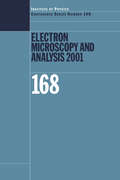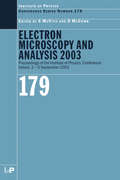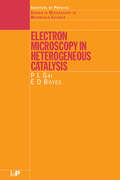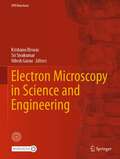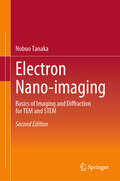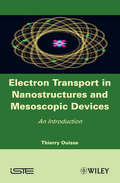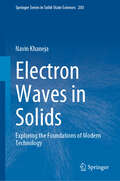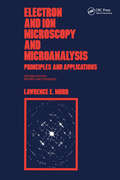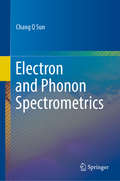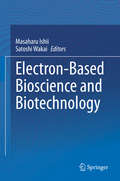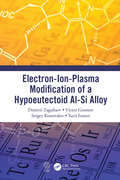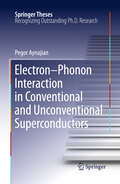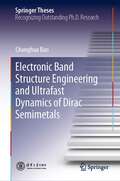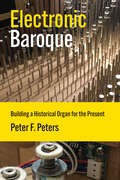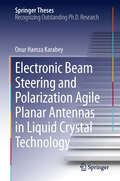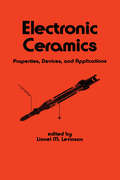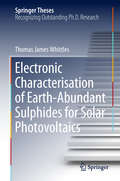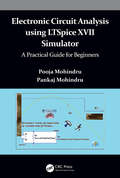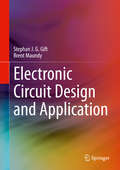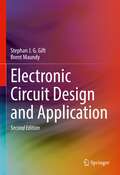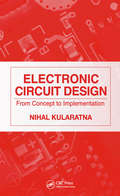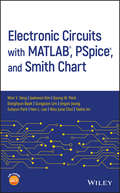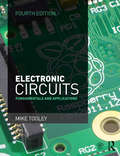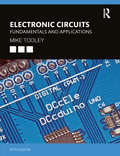- Table View
- List View
Electron Microscopy and Analysis 1997, Proceedings of the Institute of Physics Electron Microscopy and Analysis Group Conference, University of Cambridge, 2-5 September 1997
by John M. RodenburgElectron Microscopy and Analysis 1997 celebrates the centenary anniversary of the discovery of the electron by J.J. Thomson in Cambridge and the fiftieth anniversary of this distinguished Institute group. The book includes papers on the early history of electron microscopy (from P. Hawkes), the development of the scanning electron microscope at Cambridge (from K. Smith), electron energy loss spectroscopy (from L.M. Brown), imaging methods (from J. Spence), and the future of electron microscopy (from C. Humphreys). Covering a wide range of applications of advanced techniques, it discusses electron imaging, electron energy-loss and x-ray analysis, and scanning probe and electron beam microscopies. This volume is a handy reference for professionals using microscopes in all areas of physics, materials science, metallurgy, and surface science to gain an overview of developments in our understanding of materials microstructure and of advances in microscope interrogation techniques.
Electron Microscopy and Analysis 2001 (Institute of Physics Conference Series)
by M Aindow C J KielyElectron microscopy is now a mainstay characterization tool for solid state physicists and chemists as well as materials scientists. Electron Microscopy and Analysis 2001 presents a useful snapshot of the latest developments in instrumentation, analysis techniques, and applications of electron and scanning probe microscopies. The book is ideal for
Electron Microscopy and Analysis 2003: Proceedings of the Institute of Physics Electron Microscopy and Analysis Group Conference, 3-5 September 2003
by David McComb Stephen MeVitieElectron microscopy is now a mainstay characterization tool for solid state physicists and chemists as well as materials scientists. Containing the proceedings from the Electron Microscopy and Analysis Group (EMAG) conference in September 2003, this volume covers current developments in the field, primarily in the UK. These conferences are biennial
Electron Microscopy in Heterogeneous Catalysis (Series in Microscopy in Materials Science)
by P.L Gai E.D BoyesCatalysis is one of the most important technologies in the industrial world, controlling more than 90% of industrial chemical processes and essential for large-scale production of plastics and fuel. Exploring the most common type of catalysis used in industry, Electron Microscopy in Heterogeneous Catalysis provides a coherent account of heterogeneo
Electron Microscopy in Science and Engineering (IITK Directions #6)
by Krishanu Biswas Sri Sivakumar Nilesh GuraoThis issue of Direction focuses on the rapid proliferation of electron microscopy (EM) for scientific as well as technological research. The content written by leading experts is intended to provide the capabilities of EM facilities, set at Indian Institute of Technology (IIT) Kanpur to solve various problems and caters to the needs of both internal and external users. The book provides a detailed and comprehensive viewpoint of the basic features and advanced capabilities of EM facilities to the scientific community. A large number of electron microscopes have been installed and utilized by researchers across various engineering and science departments; hence, this volume provides both breadth as well as depth of various EM facilities available at the institute.
Electron Nano-imaging: Basics of Imaging and Diffraction for TEM and STEM
by Nobuo TanakaIn this second edition, most chapters of the first edition, which published in 2017, have been revised and recent advancement of electron microscopy such as differential phase contrast (DPC) STEM, sparse-coding image processing and quantum electron microscopy have been supplemented with further details. This book explains the basis of imaging and diffraction in transmission electron microscopy (TEM) and scanning transmission electron microscopy (STEM) in the style of a textbook. The book focuses on the explanation of electron microscopic imaging of TEM and STEM without including in the main text distracting information on basic knowledge of crystal diffraction, wave optics, electron lens, and scattering and diffraction theories, which are explained separately in the appendices. The comprehensive explanation is provided on the basis of Fourier transform theory, and this approach is unique in comparison with other advanced resources on high-resolution electron microscopy. With the present textbook, readers are led to understand the essence of the imaging theories of TEM and STEM without being diverted by various kinds of knowledge around electron microscopy. The up-to-date information in this book, particularly on imaging details of STEM and aberration corrections, is valuable worldwide for today’s graduate students and professionals just starting their careers.
Electron Transport in Nanostructures and Mesoscopic Devices: An Introduction
by Thierry OuisseThis book introduces researchers and students to the physical principles which govern the operation of solid-state devices whose overall length is smaller than the electron mean free path. In quantum systems such as these, electron wave behavior prevails, and transport properties must be assessed by calculating transmission amplitudes rather than microscopic conductivity. Emphasis is placed on detailing the physical laws that apply under these circumstances, and on giving a clear account of the most important phenomena. The coverage is comprehensive, with mathematics and theoretical material systematically kept at the most accessible level. The various physical effects are clearly differentiated, ranging from transmission formalism to the Coulomb blockade effect and current noise fluctuations. Practical exercises and solutions have also been included to facilitate the reader's understanding.
Electron Waves in Solids: Exploring the Foundations of Modern Technology (Springer Series in Solid-State Sciences #203)
by Navin KhanejaThis book explores the intricate world of electron behavior within solids, revealing them to be waves—a fundamental insight crucial to grasping modern electronics, computing, and solid-state devices. This comprehensive examination elucidates the factors determining material conductivity, distinguishing between conductors, insulators, and semiconductors. Through detailed analysis, the text illuminates the thermal agitation of solids, manifesting as vibrations known as phonons, which impede electron flow and contribute to electrical resistance. Readers gain insight into the production of electronic devices through semiconductor doping, exploring various device types and their functionalities. The book further investigates the temperature-dependent behavior of metal resistance, including the phenomenon of superconductivity, wherein resistance vanishes entirely at low temperatures—a phenomenon comprehensively elucidated within these pages. Moreover, the text unravels the mysteries of magnetism in solids, exploring how certain metals, such as iron, exhibit permanent magnetism. By probing into the underlying causes of magnetism, readers gain a deeper understanding of solid-state physics. Additionally, the book explores imaging techniques such as X-rays, offering insights into how scientists peer inside solids to decipher their internal structures and properties. Geared toward scientists and engineers, the book serves as an indispensable resource for mastering the foundational concepts of solid-state physics—a discipline indispensable to modern technology.
Electron and Ion Microscopy and Microanalysis: Principles and Applications, Second Edition,
by Lamrence E MurrThe publication date of the first edition is not stated, but the new edition is apparently considerably revised and expanded. It was written to serve as a multi-purpose text at the senior or graduate level and as a reference for the practicing scientist or engineer. Readers should have a math backgr
Electron and Phonon Spectrometrics
by Chang Q SunThis book presents the latest advances and future trends in electron and phonon spectrometrics, focusing on combined techniques using electron emissions, electron diffraction, and phonon absorption and reflection spectrometrics from a substance under various perturbations to obtain new information on bond-electron-phonon dynamics. Discussing the principles of the bond order-length-strength (BOLS) correlation, nonbonding electron polarization (NEP), local bond average (LBA), and multi-field lattice oscillation dynamics for systems under perturbation, the book covers topics like differential photoelectron/phonon spectrometrics (DPS), which distils transition of the length, energy, stiffness and the fraction of bonds upon chemical or physical conditioning; and the derived performance of electrons in various bands in terms of quantum entrapment and polarization. This book appeals to researchers, scientists and engineers in the fields of chemistry, physics, surface and interface science, and materials science and engineering who are interested in electron and phonon spectrometrics.
Electron-Based Bioscience and Biotechnology
by Masaharu Ishii Satoshi WakaiThis book offers a comprehensive introduction to electron-based bioscience, biotechnology, and biocorrosion. It both explains the importance of electron flow during metabolic processes in microorganisms and provides valuable insights into emerging applications in various fields. In the opening section, readers will find up-to-date information on topics such as electron transfer reactions, extracellular electron transfer mechanisms, direct interspecies electron transfer, and electron uptake by sulfate-reducing bacteria. The focus then shifts to state-of-the-art advances and applications in the field of biotechnology. Here, the coverage encompasses e.g. progress in understanding electrochemical interactions between microorganisms and conductive particles, enzymatic reactions and their application in the bioproduction of useful chemicals, and the importance of redox balance for fatty acid production. In closing, the book addresses various aspects of the complex phenomenon of microbiologically induced corrosion, highlighting novel insights from the fields of electromicrobiology and electrochemistry and their implications.
Electron-Ion-Plasma Modification of a Hypoeutectoid Al-Si Alloy
by Dmitrii Zaguliaev Victor Gromov Sergey Konovalov Yurii IvanovElectron-Ion-Plasma Modification of a Hypereutectic Al-Si Alloy details theoretical and experimental research and computer simulation of structural phase transformations in AlSi10Mn2Ni Silumin on different scale levels under electroexplosion alloying, electron beam processing and electron-plasma alloying at the nanolevel in order to create new materials. The authors summarize and analyze more than 10 years of research on the electron-ion-plasma effect on strength properties and structure-phase states’ transformations of hypoeutectic Silumin. Key Features: Details physical and mathematical models of mechanisms of surface layer hardening under conditions of varying energy effects Offers insights into improved strength characteristics of Silumin Explores optimal processing modes for increased strength and improved tribological characteristics This book is a valuable resource to researchers and engineers involved with the modification of light alloy surfaces for the automotive and aeronautical industry.
Electron-Phonon Interaction in Conventional and Unconventional Superconductors
by Pegor AynajianThe problem of conventional, low-temperature superconductivity has been regarded as solved since the seminal work of Bardeen, Cooper, and Schrieffer (BCS) more than 50 years ago. However, the theory does not allow accurate predictions of some of the most fundamental properties of a superconductor, including the superconducting energy gap on the Fermi surface. This thesis describes the development and scientific implementation of a new experimental method that puts this old problem into an entirely new light. The nominee has made major contributions to the development and implementation of a new experimental method that enhances the resolution of spectroscopic experiments on dispersive lattice-vibrational excitations (the "glue" responsible for Cooper pairing of electrons in conventional superconductors) by more than two orders of magnitude. Using this method,he has discovered an unexpected relationship between the superconducting energy gap and the geometry of the Fermi surface in the normal state, both of which leave subtle imprints in the lattice vibrations that could not be resolved by conventional spectroscopic methods. He has confirmed this relationship on two elemental superconductors and on a series of metallic alloys. This indicates that a mechanism qualitatively beyond the standard BCS theory determines the magnitude and anisotropy of the superconducting gap.
Electronic Band Structure Engineering and Ultrafast Dynamics of Dirac Semimetals (Springer Theses)
by Changhua BaoThis book highlights the doctoral research of the author on electronic band structure engineering and ultrafast dynamics of Dirac semimetals. Dirac semimetals exhibit unique electronic band structure and novel physical properties with rich light-matter interaction, which inspires a wide range of potential applications. Enabling band engineering and revealing ultrafast dynamics of Dirac semimetals is therefore important. In the research work covered by the book, the first ultrafast time- and angle-resolved photoemission spectroscopy with tunable probe photon energy is developed, providing new opportunities for exploring ultrafast dynamics in 3D quantum materials. Using the spectroscopy, the author investigates the band structure engineering and ultrafast dynamics of Dirac semimetals, realizing the long-sought-after chiral symmetry breaking in a Kekulé-ordered graphene with flat band and revealing the ultrafast dynamics of Dirac fermions in 3D Dirac semimetal for the first time. The work advances the research of the electronic structure of Dirac semimetals in two aspects. Firstly, it identifies the Kekulé-ordered graphene as a new system for exploring chiral symmetry breaking- related physics and flat band- induced instability, providing a very rare system to investigate their interplay. Secondly, it solves the long-standing challenge of directly visualizing the non-equilibrium electronic structure of 3D Dirac semimetal and opens up new opportunities for exploring the light-matter interaction in 3D quantum materials, especially the light-induced topological phase transitions in 3D topological materials.
Electronic Baroque: Building a Historical Organ for the Present (Inside Technology)
by Peter F. PetersA fascinating, real-time ethnography of the building of a unique musical instrument with both mechanical and electronic components.Electronic Baroque tells the story of how a baroque pipe organ with both a mechanical and an electronic interface was built. The book also explores how, in musical practices, the new comes into being.In 2013, the Orgelpark in Amsterdam, a concert venue dedicated to organists who want to give their instrument a new role in musical life, embarked on a project to make a unique instrument. This new baroque organ project combined principles and practices from historically informed organ building with the design and application of new computer hardware and software. Drawing on hermeneutic, pragmatist, and post-actor network theoretical approaches to history and music, Peter Peters describes and analyzes how the dual design of the organ, facing both past and present, reiterates the long history of these instruments.
Electronic Beam Steering and Polarization Agile Planar Antennas in Liquid Crystal Technology
by Onur Hamza KarabeyThis book describes the characterization of liquid crystal materials at microwave frequencies and the usage of these materials in reconfigurable planar antennas and in their electrical tunable components. It reports for the first time the realization of a two-dimensional electronic beam steering antenna and polarization agile planar antennas with liquid crystal display technology. It gives a detailed description of all the theoretical analyses, modeling and design methods that were involved in the realization of these devices as well as their validation using measurement of demonstrative prototypes. This book also shows that low profile, low cost, high gain, electronic beam steering and polarization agile antennas can be fabricated in larger sizes by using existing automated liquid crystal display manufacturing techniques. The innovative ideas and method described in this work represent a considerable advancement in the field of electronically reconfigurable antennas based on liquid crystal technology and are expected to draw significant interest in the future. Such antennas may become important, for example, in mobile terminals integrated into the body of laptops (in the cover) or of automobiles (in the rooftop), ships or boats, for which flat, low-profile and low-cost antennas are required.
Electronic Ceramics: Properties: Devices, and Applications
by L. LevinsonThis book focuses on the properties and configuration of the ceramic which facilitates proper application of material to the task at hand. It is intended for workers in electronics, ceramics, computers, or telecommunications fields, to broaden their expertise in the area of electronic ceramics.
Electronic Characterisation of Earth‐Abundant Sulphides for Solar Photovoltaics (Springer Theses)
by Thomas James WhittlesThis book examines the electronic structure of earth-abundant and environmentally friendly materials for use as absorber layers within photovoltaic cells. The corroboration between high-quality photoemission measurements and density of states calculations yields valuable insights into why these materials have demonstrated poor device efficiencies in the vast literature cited. The book shows how the materials’ underlying electronic structures affect their properties, and how the band positions make them unsuitable for use with established solar cell technologies. After explaining these poor efficiencies, the book offers alternative window layer materials to improve the use of these absorbers. The power of photoemission and interpretation of the data in terms of factors generally overlooked in the literature, such as the materials’ oxidation and phase impurity, is demonstrated. Representing a unique reference guide, the book will be of considerable interest and value to members of the photoemission community engaged in solar cell research, and to a wider materials science audience as well.
Electronic Circuit Analysis using LTSpice XVII Simulator: A Practical Guide for Beginners
by Pooja Mohindru Pankaj MohindruThis text discusses simulation process for circuits including clamper, voltage and current divider, transformer modeling, transistor as an amplifier, transistor as a switch, MOSFET modeling, RC and LC filters, step and impulse response to RL and RC circuits, amplitude modulator in a step-by-step manner for more clarity and understanding to the readers. It covers electronic circuits like rectifiers, RC filters, transistor as an amplifier, operational amplifiers, pulse response to a series RC circuit, time domain simulation with a triangular input signal, and modulation in detail. The text presents issues that occur in practical implementation of various electronic circuits and assist the readers in finding solutions to those issues using the software. Aimed at undergraduate, graduate students, and academic researchers in the areas including electrical and electronics and communications engineering, this book: Discusses simulation of analog circuits and their behavior for different parameters. Covers AC/DC circuit modeling using regular and parametric sweep methods. The theory will be augmented with practical electrical circuit examples that will help readers to better understand the topic. Discusses circuits like rectifiers, RC filters, transistor as an amplifier, and operational amplifiers in detail.
Electronic Circuit Design and Application
by Stephan J. Gift Brent MaundyThis textbook for core courses in Electronic Circuit Design teaches students the design and application of a broad range of analog electronic circuits in a comprehensive and clear manner. Readers will be enabled to design complete, functional circuits or systems. The authors first provide a foundation in the theory and operation of basic electronic devices, including the diode, bipolar junction transistor, field effect transistor, operational amplifier and current feedback amplifier. They then present comprehensive instruction on the design of working, realistic electronic circuits of varying levels of complexity, including power amplifiers, regulated power supplies, filters, oscillators and waveform generators. Many examples help the reader quickly become familiar with key design parameters and design methodology for each class of circuits. Each chapter starts from fundamental circuits and develops them step-by-step into a broad range of applications of real circuits and systems.Written to be accessible to students of varying backgrounds, this textbook presents the design of realistic, working analog electronic circuits for key systems;Includes worked examples of functioning circuits, throughout every chapter, with an emphasis on real applications;Includes numerous exercises at the end of each chapter;Uses simulations to demonstrate the functionality of the designed circuits;Enables readers to design important electronic circuits including amplifiers, power supplies and oscillators.
Electronic Circuit Design and Application
by Stephan J. Gift Brent MaundyThis textbook for core courses in Electronic Circuit Design teaches students the design and application of a broad range of analog electronic circuits in a comprehensive and clear manner. Readers will be enabled to design complete, functional circuits or systems. The authors first provide a foundation in the theory and operation of basic electronic devices, including the diode, bipolar junction transistor, field effect transistor, operational amplifier and current feedback amplifier. They then present comprehensive instruction on the design of working, realistic electronic circuits of varying levels of complexity, including power amplifiers, regulated power supplies, filters, oscillators and waveform generators. Many examples help the reader quickly become familiar with key design parameters and design methodology for each class of circuits. Each chapter starts from fundamental circuits and develops them step-by-step into a broad range of applications of real circuits and systems.Written to be accessible to students of varying backgrounds, this textbook presents the design of realistic, working analog electronic circuits for key systems;Includes worked examples of functioning circuits, throughout every chapter, with an emphasis on real applications;Includes numerous exercises at the end of each chapter;Uses simulations to demonstrate the functionality of the designed circuits;Enables readers to design important electronic circuits including amplifiers, power supplies and oscillators.
Electronic Circuit Design: From Concept to Implementation
by Nihal KularatnaWith growing consumer demand for portability and miniaturization in electronics, design engineers must concentrate on many additional aspects in their core design. The plethora of components that must be considered requires that engineers have a concise understanding of each aspect of the design process in order to prevent bug-laden prototypes. Electronic Circuit Design allows engineers to understand the total design process and develop prototypes which require little to no debugging before release. It providesstep-by-step instruction featuring modern components, such as analog and mixed signal blocks, in each chapter. The book details every aspect of the design process from conceptualization and specification to final implementation and release. The text also demonstrates how to utilize device data sheet information and associated application notes to design an electronic system. The hybrid nature of electronic system design poses a great challenge to engineers. This book equips electronics designers with the practical knowledge and tools needed to develop problem free prototypes that are ready for release.
Electronic Circuits with MATLAB, PSpice, and Smith Chart
by Kyung W. Park Won Y. Yang Jaekwon Kim Taeho Im Donghyun Baek Sungjoon Lim Jingon Joung Suhyun Park Han L. Lee Woo June ChoiProvides practical examples of circuit design and analysis using PSpice, MATLAB, and the Smith Chart This book presents the three technologies used to deal with electronic circuits: MATLAB, PSpice, and Smith chart. It gives students, researchers, and practicing engineers the necessary design and modelling tools for validating electronic design concepts involving bipolar junction transistors (BJTs), field-effect transistors (FET), OP Amp circuits, and analog filters. Electronic Circuits with MATLAB®, PSpice®, and Smith Chart presents analytical solutions with the results of MATLAB analysis and PSpice simulation. This gives the reader information about the state of the art and confidence in the legitimacy of the solution, as long as the solutions obtained by using the two software tools agree with each other. For representative examples of impedance matching and filter design, the solution using MATLAB and Smith chart (Smith V4.1) are presented for comparison and crosscheck. This approach is expected to give the reader confidence in, and a deeper understanding of, the solution. In addition, this text: Increases the reader's understanding of the underlying processes and related equations for the design and analysis of circuits Provides a stepping stone to RF (radio frequency) circuit design by demonstrating how MATLAB can be used for the design and implementation of microstrip filters Features two chapters dedicated to the application of Smith charts and two-port network theory Electronic Circuits with MATLAB®, PSpice®, and Smith Chart will be of great benefit to practicing engineers and graduate students interested in circuit theory and RF circuits.
Electronic Circuits, 4th ed: Fundamentals & Applications
by Mike TooleyElectronics explained in one volume, using both theoretical and practical applications. New chapter on Raspberry Pi Companion website contains free electronic tools to aid learning for students and a question bank for lecturers Practical investigations and questions within each chapter help reinforce learning Mike Tooley provides all the information required to get to grips with the fundamentals of electronics, detailing the underpinning knowledge necessary to appreciate the operation of a wide range of electronic circuits, including amplifiers, logic circuits, power supplies and oscillators. The fourth edition now offers an even more extensive range of topics, with extended coverage of practical areas such as Raspberry Pi. The book's content is matched to the latest pre-degree level courses (from Level 2 up to, and including, Foundation Degree and HND), making this an invaluable reference text for all study levels, and its broad coverage is combined with practical case studies based in real-world engineering contexts. In addition, each chapter includes a practical investigation designed to reinforce learning and provide a basis for further practical work. A new companion website at www.key2electronics.com offers the reader a set of spreadsheet design tools that can be used to simplify circuit calculations, as well as circuit models and templates that will enable virtual simulation of circuits in the book. These are accompanied by online self-test multiple choice questions for each chapter with automatic marking, to enable students to continually monitor their own progress and understanding. A bank of online questions for lecturers to set as assignments is also available.
Electronic Circuits: Fundamentals and Applications
by Mike TooleyElectronics explained in one volume, using both theoretical and practical applications. Mike Tooley provides all the information required to get to grips with the fundamentals of electronics, detailing the underpinning knowledge necessary to appreciate the operation of a wide range of electronic circuits, including amplifiers, logic circuits, power supplies and oscillators. The 5th edition includes an additional chapter showing how a wide range of useful electronic applications can be developed in conjunction with the increasingly popular Arduino microcontroller, as well as a new section on batteries for use in electronic equipment and some additional/updated student assignments. The book's content is matched to the latest pre-degree level courses (from Level 2 up to, and including, Foundation Degree and HND), making this an invaluable reference text for all study levels, and its broad coverage is combined with practical case studies based in real-world engineering contexts. In addition, each chapter includes a practical investigation designed to reinforce learning and provide a basis for further practical work. A companion website at http://www.key2electronics.com offers the reader a set of spreadsheet design tools that can be used to simplify circuit calculations, as well as circuit models and templates that will enable virtual simulation of circuits in the book. These are accompanied by online self-test multiple choice questions for each chapter with automatic marking, to enable students to continually monitor their own progress and understanding. A bank of online questions for lecturers to set as assignments is also available.

